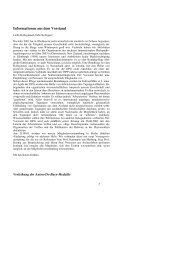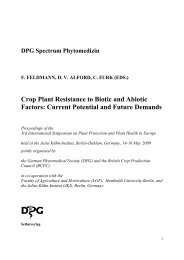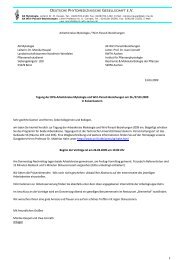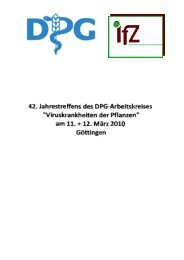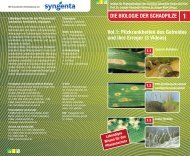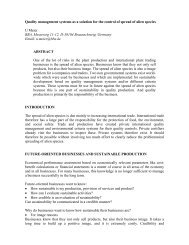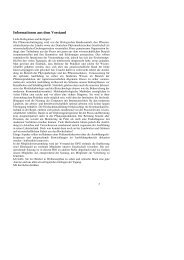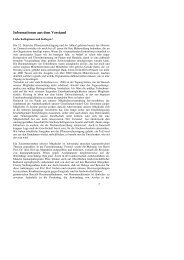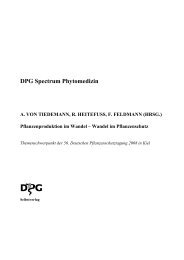PHYTO MEDIZIN Mitteilungen der Deutschen ... - Die DPG
PHYTO MEDIZIN Mitteilungen der Deutschen ... - Die DPG
PHYTO MEDIZIN Mitteilungen der Deutschen ... - Die DPG
Sie wollen auch ein ePaper? Erhöhen Sie die Reichweite Ihrer Titel.
YUMPU macht aus Druck-PDFs automatisch weboptimierte ePaper, die Google liebt.
esults. The real-time RT-PCR protocol developed by Boonham et al. (Journal<br />
of Virological Methods 116, 139146, 2004) performed extremely well in<br />
a recent ring test, comparing different PSTVd detection methods in several<br />
laboratories. In addition, real-time PCR technology has proved suitable for<br />
highthroughput testing. Therefore, this method was chosen as the starting<br />
point for the development of a protocol for the large-scale testing of potato.<br />
The initial experiments focused on the specificity of the primers and probes<br />
with regard to different isolates of PSTVd and other (pospi-) viroids. Further<br />
experiments performed with leaf material concerned sampling position,<br />
growing-on temperature and bulking rate. In addition, different grinding and<br />
nucleic-acid extraction methods were compared. To monitor false negatives<br />
and positives, different controls were included. The final protocol was tested<br />
using a hundred samples from the Dutch potato monitoring programme. Future<br />
plans include the development of a protocol for direct tuber testing and<br />
inter-laboratory ring testing of the protocols.<br />
Multiple infections of commercial Poinsettia<br />
H Jeske, M aus dem Siepen, B-J Koo, JO Pohl and C Wege; Institute of Biology,<br />
Department of Plant Molecular Biology and Virology, University of Stuttgart<br />
Commercial Poinsettia (Euphorbia pulcherrima Willd.) are frequently infected<br />
by three agents, a beneficial phytoplasm and two viruses which were<br />
formerly named Poinsettia mosaic virus (PnMV) and Poinsettia cryptic virus,<br />
and classified as tymo- and cryptic virus, respectively. The sequence analysis<br />
of both viruses requires a revision of the taxonomy now which may have<br />
important implications for quarantine measures in greenhouse propagation of<br />
Poinsettia. PnMV is more closely related to marafiviruses than to tymoviruses.<br />
The second virus (now named Poinsettia Latent virus, PnLV) showed<br />
an unprecedented hybrid genome structure combining the first two thirds of a<br />
polerovirus - providing functions for replication - and one third of a sobemovirus<br />
coding for the coat protein. The extreme 5’ and 3’ ends which harbour<br />
the putative origins of replication resemble those of poleroviruses.<br />
Whereas marafiviruses are transmitted by leafhoppers, sobemoviruses may<br />
be spread via soil and watering, a route which would explain the frequent reoccurence<br />
of the Poinsettia viruses in plant material that had been tested<br />
virus-free before. Un<strong>der</strong> these perspectives much more care should be taken<br />
in greenhouses to prevent mechanical dissemination than with the assumption<br />
of a cryptic virus. Since PnMV frequently re-occurred together with PnLV -<br />
even in quarantine facilities – it may be interesting to search for a genetic<br />
dependence of both viruses in future.<br />
36




